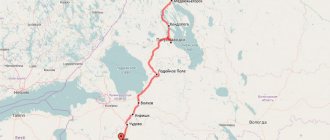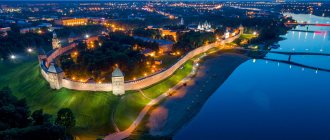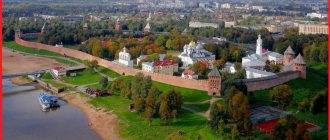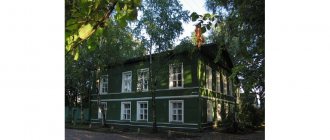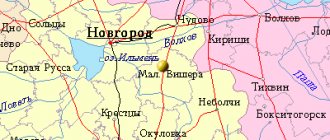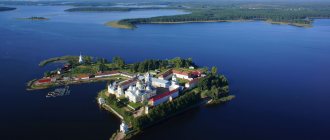Number 53 on car license plates indicates vehicle registration in the Novgorod region . The subject was formed in the summer of 1944 by decree of the Presidium of the USSR Armed Forces on the basis of areas withdrawn from the Leningrad and Kalinin regions. Subsequently, the list of reporting territories was adjusted several times, in the mid-90s. last century, the subject received code 53 (in accordance with the position of the region according to the list approved in the Constitution of the RSFSR of 1978).
Main city
The center of the subject of the Russian Federation 53 is Veliky Novgorod , founded in 859 and having the name Novgorod until 1999. The population, according to data for 2022, is almost 225 thousand people. (almost 33% of the region’s residents). The city is divided into 2 asymmetrical parts by the Volkhov River. At a distance of 6 km from Veliky Novgorod there is a large freshwater lake Ilmen.
Federal District
The region's territory is part of the Northwestern Federal District , which also includes:
- Arkhangelsk, Vologda, Kaliningrad, Leningrad, Murmansk and Pskov regions;
- Republics of Karelia and Komi;
- Nenets Autonomous Okrug
- city of St. Petersburg (capital of the district).
Yandex.Maps Northwestern Federal District — Yandex.Maps
Coat of arms of the region
The region of the Russian Federation with code 53 has a coat of arms consisting of a central silver field with 2 symmetrical black bears holding a golden throne on a pedestal (the seat has a red cushion). Along the perimeter are oak leaves and St. Andrew's blue ribbon; on top of the shield is the imperial crown. The coat of arms was approved in the fall of 1995 and has not changed over the subsequent years.
Archaeological research
The main medieval monument of Novgorod is its cultural layer, reaching 9 m. Clay soils do not allow air to pass through and do not absorb moisture, water oozes through the layers, preventing the access of air, thereby eliminating the process of decay of organic residues. Products made of wood, metal, bone, and leather are well preserved. The complete preservation of the layers corresponding to narrow periods of time makes it possible to clarify the ancient layout of the excavated area. The objects found in them make it possible to understand the purpose of the buildings, the standard of living of the inhabitants, and the nature of their occupations. Thousands of log buildings have been opened. The size of the estates reaches 300-1500 square meters. m. A weather dendrochronological scale has been developed; material complexes are dated with an accuracy of up to 10 years. The oldest pavement dates back to 953. Among the things found were ships, sleighs, furniture, utensils, dishes, children's toys, musical instruments, weapons, and jewelry.
The oldest (first half of the 11th century) of almost eight hundred birch bark letters preserved the text of the conspiracy in ancient German: “Never hit him with an arrow.” Around the same time, an exquisite message from a young woman with a high social position and familiar with the literary language to her lover who did not come on a date dates back to her: “What kind of evil do you have against me that you didn’t come to me this week? And I treated you like a brother! Did I really offend you by sending you? But I see you don’t like it. If you cared, you would have escaped from under (human) eyes and come... now somewhere else. Write to me about... (don’t think that I) am rejecting you. Even if I “hurt you with my stupidity,” if you start to mock me, then God and “my thinness” (= me) will judge (you). The ceras (waxed tablets for writing) with the texts of the Psalter (ninth kathisma) and an unparalleled text of a conspiracy or sermon, found in 2000, date back no later than the first quarter of the 10th century. and are the oldest surviving Slavic texts.
Archaeological sources also make it possible to resolve fundamental issues in the history of material and spiritual culture, economics and politics. Linguistic analysis of birch bark texts led to the discovery of the Old Novgorod dialect, related to the languages of the Slavs of the southern Baltic (which means the Slavs came here not from the middle Dnieper region, as previously thought, but from the Western Slavic regions). The second important observation concerns the reasons for the emergence of a boyar republic in Novgorod. Early birch bark letters showed that state taxes were initially collected by the aristocratic elite of society on the basis of an agreement with the prince, which formed the basis of its economic power. The layer of other cities preserves only a negligible part of the antiquities, while Novgorod allows us to reconstruct an almost complete picture of the life of medieval townspeople. During excavations carried out since 1932, archaeologists have explored no more than 2% of the ancient territory. All R. 16th century the market housed more than 1,500 shops, and there were over 200 craft professions. During the Time of Troubles, Novgorod suffered from the Swedish occupation (1611-1617).
Big cities
The list of major settlements includes:
- Velikiy Novgorod ;
- Staraya Russa (about 28 thousand inhabitants);
- Borovichi (about 49 thousand people).
Other cities in the region have from 8.5 to 15 thousand inhabitants. For example, in Valdai, according to data at the beginning of 2020, just under 14 thousand people are registered, the same number of people live in the city of Chudovo. The smallest is Holm, founded in 1144. As of 2022, the number of inhabitants is about 3.4 thousand people. According to statistics, the population of cities in the region is declining (except for Veliky Novgorod). As a result of extinction, the settlements of Demyansk and Kresttsy lost the title of cities and moved into the category of urban-type settlements.
Historical and urban planning essay
Novgorod is one of the most ancient urban tribal cities (“The Tale of Bygone Years”). It was first mentioned in the Novgorod I Chronicle in 859. At this time, the city was still located on the site of the current “Rurik” settlement. The location at the junction of the routes “from the Varangians to the Greeks” (established in the 9th century) with the “Volga-Baltic” route (established by the end of the 8th century) contributed to the development of crafts (iron, wood, leather processing), trade and culture in Novgorod. The city was “moved” to a new location in the 930-50s.
The construction of Detinets and the emergence of the settlement were almost simultaneous, and very quickly the city occupied a huge area.
Detinets, the name of the internal fortifications (walls and towers) in a Russian medieval city around the residence of a prince or bishop. The term was used in chronicles until the 14th century; later it was replaced by the name “Kremlin” or the words “grad” and “city” that existed simultaneously with it.
From the end 10th century this is already the second most important center of Kievan Rus with the 13-domed wooden Church of St. Sophia. After the redevelopment of the Kremlin, the stone St. Sophia Cathedral (1045-50) was built in the new Detinets, one of the three oldest, along with Kyiv and Polotsk, St. Sophia churches in Rus'. From the beginning In the 12th century, starting from the Church of the Annunciation on Gorodishche in Novgorod, intensive construction of stone churches was carried out. The Nikolodvorishchensky, Anthony's Nativity, and St. George churches of this period have been preserved.
At this time, Novgorod begins to invite the prince without the consent of Kiev. The veche—a people's assembly with the participation of the urban and rural population—gained great importance in the political life of Novgorod. The veche elected the townsman, thousand and archbishop from among the boyars (since 1156). The land rights and income of the Kyiv prince were transferred to the archbishop who stood at the head of the executive power. He was in charge of the treasury, foreign relations, and the court. Key positions in the management of the Novgorod state gave him the chairmanship of the council of gentlemen. Traveler Guilbert Lannoy at the beginning of the 15th century. called the ruler of Novgorod the lord of the city. The trade and craft population had their own Konchan, sotny (including merchants), and Ulich associations. The functions of the prince were limited mainly to the military leadership.
The basis of the economy of Novgorod in the 12-15th centuries. - agriculture and cattle breeding, hunting, fishing, highly developed crafts, exchange with the surrounding area and trade. Furs, honey, wax, flax, leather raw materials, hemp, and timber were exported. Cloth, luxury goods, spices, and wine were imported. Novgorod carried out active colonization of the North-East (Zavolochye), rich in furs, fish, salt, walrus ivory, and pearls. Novgorod founded cities, including Vologda (1147) and Totma (until 1138). Land holdings served as the material basis for the political domination of the boyars and the church. There was a middle class - “living people, native people.”
| K ser. 12th century The architectural face of Novgorod was completely defined. The center had a two-part structure: on the left bank - the Sofia side with the Kremlin (Detinets), on the right bank - |
The trading side with the originally princely Yaroslav's courtyard, where the veche met. Both parts were connected by a bridge across the Volkhov. Already at the beginning 12th century the city and its immediate surroundings along the river were surrounded by stone temples. Urban development on an area of 410 hectares within the 12th century fort. was divided into 5 districts (ends). Around Detinets from north to south there are Nerevsky, Zagorodsky and Goncharsky, or Lyudin, ends, around Torg there is the Slavensky end, to the north of it behind the Fedorovsky stream there is the Plotnitsky end. From the 14th century the ends act as self-governing constituent units. In the 15th century they turn out to be connected with the parts of the state subject to them - Pyatina (Bezhetskaya, Vodskaya, Derevskaya, Obonezhskaya, Shelonskaya). Most of the streets gravitated towards the banks of the Volkhov, parallel to which, on each side, only one street crossed the city along its entire length.
At this time, Novgorod developed into a huge urban complex. The city was surrounded by 3 rows of monasteries. Residential development to the end. 17th century was wooden. Temples, sometimes chambers of the nobility, and defensive structures were built from stone and brick. On the territory of Detinets, the buildings of the ruler’s court with the “faceted chamber” (1433), the walls and towers of the first “Italian” Kremlin in Rus' have been preserved. 15th century
A huge number of churches have been preserved: Blagoveshchensky Arkazhsky, Peter and Paul on Sinichya Mountain, Spaso-Nereditsky from the end of the 12th century, Pyatnitsky at Torg, Rozhdestvensky Perynsky (beginning of the 13th century), Nikolo-Lipensky, Fedorovsky (late 13th century), St. Nicholas the Bely , Mikhailovsky, Savior on Kovalev (early and mid-14th century), John on Vitka, Nativity on the Cemetery, Fyodor on the Stream, Savior on Ilyin (2nd half of the 14th century), Blasius, Peter and Paul in Kozhevniki (early 15th century), Assumption, John on Opoki, Twelve Apostles, Forty Martyrs, Sergius in the Kremlin (mid 15th century).
| Almost all temples contain significant fragments of fresco painting. The most famous are the frescoes of Sofia, Antonov, Arkazh, Nereditsa (12th century), Fyodor, Nativity and the Savior on Kovalevo (14th century). After the destruction of the temples in the 1940s, the frescoes were collected by restorers Grekov and glued back together. Temple 14th century — Spas on Ilyina Street — painted by Feofan the Greek. Novgorod also houses a rich collection of icons from the 11th to 20th centuries. In the St. Sophia Cathedral, in addition to the iconostases, there is the oldest shrine of Novgorod - the icon “The Sign”, according to legend, which saved the city from the Suzdal army in 1170. |
Nationalities
On the territory of Veliky Novgorod (region number - 53) and the region there live (according to the 2010 census) several main nationalities. The percentage composition is given in the table.
| Nationality | Share of population, % |
| Russians | 88,36 |
| Ukrainians | 1,11 |
| Gypsies | 0,57 |
| Belarusians | 0,54 |
| Other nationalities | 2,37 |
| Those who have not decided on nationality or have not provided information | 7,05 |
Industry
In 2009, large and medium-sized manufacturing enterprises shipped goods of their own production, performed work and services in the amount of 45.54 billion rubles. In 2008, large and medium-sized manufacturing enterprises shipped goods of their own production, performed work and services in the amount of 54.21 billion rubles. The main ones are: • chemical production ranks first in terms of volumes of goods shipped - 28.4 billion rubles, • in second place is the production of food products, including drinks - 10.8 billion rubles, • production of machinery and equipment - 5.1 billion rub. • production of cardboard packaging, publishing and printing activities - 4.3 billion rubles. • metallurgical production - 2.1 billion rubles.
Administrative division
The 53rd region of Russia is divided into:
- 3 large cities of regional significance;
- 7 small towns that are regional centers ( region 53 is one of the outsiders in the Russian Federation );
- 11 urban-type settlements;
- 113 settlements;
- number of small villages not stated in official reports.
Monuments of the late Middle Ages
| Many temples have also reached us from the late 16th century (Procopius, Women of the Myrrh-Bearers, Savior on Khutyn), ser. 16th century (Philip on Nutnaya, Boris and Gleb in Plotniki, Nikita, Fyodor Tiron, several refectories). The subsequent more than 100-year period is not represented by anything. From the end of the 17th century. The Znamensky Cathedral and two suburban monasteries - Derevyanitsky and Vyazhishchisky - have been preserved. Both provide very unique examples of heavy-style buildings with patterns. In the Kremlin there are also a clock ringing (1673), Likhudov and the Nikitsky building from the 15th-17th centuries, a house with platbands at the Belfry. |
Provincial city
Until the beginning 18th century Novgorod remained one of the major economic and shopping centers. With the development of St. Petersburg, it is gradually losing its trade and economic importance, remaining one of the centers of flax growing. Since 1727 it has been a provincial town. In the end 18th - early 19th centuries the radial-semicircular layout of the Sofia side and the rectangular one on the Trade side were streamlined (general plans of 1778 and 1834). Fragments of the historical environment and buildings in the classicist style have been preserved (Travel Palace 1771, 1828; Guardhouse). Public places (18-19 centuries, now one of the museum buildings), the monument “Millennium of Russia” (1862, sculptor M. O. Mikeshin, architect V. A. Hartman). In the 19th century, Novgorod was a place of political exile (Herzen 1841, participants in the strike movement - 1890s). Weak industry - in 1913 there were only 17 enterprises, 450 workers.
Post-revolutionary period
In November 1917, Soviet power came to the city. In January 1918 he survived the revolt of the Socialist Revolutionaries and Mensheviks. In 1939 it had 69 industrial enterprises (ship repair, foundry, and tile factories). The number of workers (since 1913) has increased 20 times. From August 15, 1941 to January 19, 1944 it was occupied by Nazi troops. After the occupation, out of 2,532 residential buildings, 40 remained.
After the war, electrical and radio engineering, chemical, light and food industries, and the production of building materials developed. Leading industrial enterprises of modern Novgorod: JSC "Akron" (mineral fertilizers, plastics, "Transvit" (video recorders), capacitors, transistors for satellite TV, radios, telephones, equipment for diagnosing car repairs. Enterprises of the furniture, glass, food industries, production building materials. Institutes: pedagogical, polytechnic, branch of the St. Petersburg Agricultural Institute. Colleges - electrical engineering, construction, cooperative, state farm technical school. Medical, music and cultural education school. Drama Theatre. Philharmonic Society. Tourism center (tourist centers, campsites). Historical and architectural museum. -reserve with a branch - the Museum of Wooden Architecture.
According to the master plans for the restoration and development of A.V. Shchusev (1944-45), “Giprogora” (1966), the Sofia side, Peterburgskaya, Moskovskaya streets are built up with new houses, the compositional axis from the station (design by A.V. Shchusev) through the Kremlin is clearly marked, across the Volkhov Bridge, to Spas on Ilyin. During the reform years of the 1990s. Novgorod is becoming one of the leading cities in the country in terms of the number of private enterprises.
Transport
Transport in the region is represented by:
- railways;
- highways of various subordination;
- air communication lines (limited by the lack of an airfield);
- small river vessels.
Air
There is no official airport; there are sporadic charter flights using army airfields in Staraya Russa and Soltsy. Since 2022, the reconstruction of the Krechevitsy military airfield within the boundaries of Veliky Novgorod has been underway, which is expected to be used for the needs of civil aviation.
Automotive
The following trails pass through the territory:
- federal M10 (“ Russia ”, connecting Moscow and St. Petersburg);
- federal P56;
- M11 expressway.
The total length of highways is almost 15 thousand km, some of the objects are of federal importance (about 3%), the rest are assigned to municipalities or belong to local routes of communication.
Railway
The regional center is connected by railways with the capitals of neighboring regions and other large cities (for example, Moscow, St. Petersburg, Minsk or Brest). Construction of additional highways for the delivery of goods and transportation of tourists is underway.
Water
River transport in the region is poorly developed and is represented by private boats and small vessels. There are tourist routes that transport people on motorized boats.
Culture
Novgorod has always been a center of culture and art. Chronicle writing was carried out here, and literacy was widespread. Most of the famous Russian books are from the 11th-15th centuries. written in Novgorod. The history of Novgorod is colored with tales, legends, epics (about Vasily Buslaev, Sadko). D. S. Likhachev highly appreciated the cultural significance of Novgorod: “We owe it to the people of Novgorod that we are who we are, that we are Russians.” In the 13th-15th centuries. Novgorod played the role of a shield that protected Rus' from the aggression of the Swedes and Livonian knights. Novgorod did not suffer from the Tatar-Mongols, although it recognized it in the 13-14th centuries. dependence on the Golden Horde and paid tribute. From the 14th century Moscow and Lithuania sought to subjugate Novgorod. In 1397 Moscow seized the Dvina land for a year.
In 1470 Novgorod negotiated an alliance with Lithuania. In 1478, as a result of the Battle of Shelon and the siege, the veche bell was removed, and the republic finally became part of Moscow.
Attractions
On the territory of the subject there are a large number of monasteries and cathedrals, some of which were built before the 18th century. For example, within the boundaries of Veliky Novgorod, the Alekseevskaya or White Tower, built no later than the 16th century, has been preserved. to protect the populated area. Attractions include the Museum of the North-Western Front, located in Staraya Russa, the house-museum of F.M. Dostoevsky. Since the beginning of the 2010s. Ethnographic parks are being built (for example, the Slavic Village, depicting a settlement of the early 10th century).
Icon "The Sign"
| “ The Sign ” Novgorod Icon of the Mother of God, the oldest Russian miraculous icon of the Mother of God, the main shrine of Veliky Novgorod and the Russian North. She was revered as the patroness of Novgorod already in the 12th century. The legend, compiled in the 14th century on the basis of ancient sources, says that on February 25, 1169, during the siege of Novgorod by the troops of the Suzdal prince Andrei Bogolyubsky, the icon was taken to the city wall; one of the arrows of the besiegers hit the image of the Mother of God, the icon turned its face to the city, tears flowed from the eyes of the Mother of God; Amazed by this miracle, the Suzdal residents began to attack each other in panic and were defeated by the Novgorodians. In the 15th-16th centuries, icons depicting this miracle were painted in Novgorod. At the end of the 15th and beginning of the 16th centuries, the miraculous icon received the name “The Sign” (meaning a sign of God’s mercy). The icon was widely revered in subsequent centuries, becoming an all-Russian shrine. |
The Novgorod Icon “The Sign” was created in the first half of the 12th century. According to the iconography, it is a half-length image of Oranta, on the chest of the Mother of God there is a medallion with the image of the blessing of the Christ Child. On the other side are saints (either Peter and Anastasia, or Joachim and Anna - inscriptions with their names have not been preserved), represented by those praying to the image of Christ. Over the centuries, the icon was restored many times; in 1565 it was renewed by Metropolitan Macarius. From the 12th century painting, only fragments of the blue robe of the Mother of God on the front side and images of saints on the back have survived. At the beginning of the 20th century, the icon had a massive gold frame with precious stones.
Initially, the icon was located in the Church of the Transfiguration on Ilyin Street; in the mid-15th century it was moved to the church of the same name built for it. During the years of Soviet power, the icon was kept in the Novgorod Museum; currently - in the Novgorod St. Sophia Cathedral, newly opened for worship. Throughout the 12th-19th centuries, numerous copy copies of the icon were made, which were widely revered throughout Russia; the most famous of them: Abalatskaya (1637, the main shrine of Siberia), Tsarskoye Selo (in the Znamenskaya Church of Tsarskoe Selo; considered the Romanov family shrine), Seraphim-Ponetaevskaya (1879, the main shrine of the Seraphim-Ponetaevsky women's monastery).
Celebration - November 27 (December 10).

